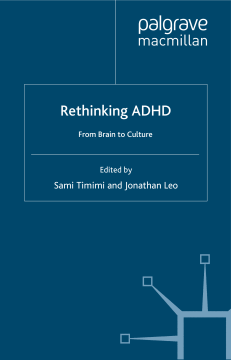
Additional Information
Book Details
Abstract
This book brings together, for the first time, a selection of international critiques on the role of ADHD in our society today, looking at how diagnoses have increased in recent years and the reasons behind this. Topics range from genetics to social culture, offering a comprehensive overview of this area.
SAMI TIMIMI is a consultant child and adolescent psychiatrist in the National Health Service in Lincolnshire and a visiting Professor at Lincoln University, UK. He writes from a critical psychiatry perspective on topics relating to child and adolescent mental health and has published articles on many topics including eating disorders, psychotherapy, behavioural disorders and cross-cultural psychiatry. He has authored three books, Pathological Child Psychiatry and the Medicalization of Childhood, (Brunner-Routledge, 2002); Naughty Boys: Anti-Social Behaviour, ADHD and the Role of Culture, (Palgrave Macmillan, 2005); Mis-Understanding ADHD: The Complete Guide for Parents to Alternatives to Drugs, (AuthorHouse, 2007), and has co-edited with Dr Begum Maitra, Critical Voices in Child and Adolescent Mental Health, (Free Association Books, 2006).
JONATHAN LEO, Ph.D. is Associate Professor of Neuroanatomy at Lincoln Memorial University. He has published numerous articles about the biological theories of mental health, covering topics such as the genetic basis of schizophrenia, the serotonin theory of depression, the paediatric trials of selective serotonin reuptake inhibitors, and ADHD. His articles have been published in Society, Skeptic, and The Journal of Mind and Behavior. He is the past Editor-in-Chief of Ethical Human Psychology and Psychiatry. His most recent article, co-authored with Jeff Lacasse, was about the disconnect between the scientific literature and the popular advertisements regarding serotonin and depression. The paper was published in The Public Library of Science (PLoS) and was subsequently covered by numerous media outlets including WebMD, Nature, Forbes, The Scientist, and the Wall Street Journal.
...a great deal of convincingly presented information that equips the reader to challenge proponents of the ADHD diagnosis and treatment with stimulants and propose other perspectives.' - Mental Health
Table of Contents
| Section Title | Page | Action | Price |
|---|---|---|---|
| Cover | Cover | ||
| Contents | v | ||
| List of Figures and Tables | vii | ||
| Notes on the Contributors | ix | ||
| Acknowledgements | xiv | ||
| Introduction | 1 | ||
| Part I: ADHD and the Medical Model | 19 | ||
| 1 ADHD: What Do We Really Know? | 21 | ||
| 2 ADHD and Genetics: A Consensus Reconsidered | 58 | ||
| 3 A Critical Review of ADHD Neuroimaging Research | 92 | ||
| Part II: ADHD and Culture | 131 | ||
| 4 Why Diagnosis of ADHD has Increased so Rapidly in the West: A Cultural Perspective | 133 | ||
| 5 Clinical Psychology and Attention Deficit Hyperactivity Disorder | 160 | ||
| 6 ADHD in Australia: The Emergence of Globalization | 169 | ||
| 7 ADHD and Globalization | 198 | ||
| 8 Social Deprivation or Brain Dysfunction? Data and the Discourse of ADHD in Britain and North America | 218 | ||
| Part III: ADHD Drug Therapies | 253 | ||
| 9 The Case against Stimulants | 255 | ||
| 10 The Manipulation of Data and Attitudes about ADHD: A Study of Consumer Advertisements | 287 | ||
| 11 The Deficiencies of Drug Treatment Research: The Case of Strattera™ | 313 | ||
| 12 The Role of Diet and Nutrition in ADHD | 334 | ||
| Part IV: Alternative Paradigms for ADHD | 347 | ||
| 13 Mind Magic | 349 | ||
| 14 ADHD and Other Sins of Our Children | 360 | ||
| 15 Canaries in the Coal Mine | 382 | ||
| 16 ‘Good’ Science, Expectations, Villains, and Hope | 398 | ||
| Index | 413 | ||
| A | 413 | ||
| B | 414 | ||
| C | 414 | ||
| D | 415 | ||
| E | 415 | ||
| F | 415 | ||
| G | 416 | ||
| H | 416 | ||
| I | 416 | ||
| J | 416 | ||
| K | 416 | ||
| L | 416 | ||
| M | 416 | ||
| N | 416 | ||
| O | 417 | ||
| P | 417 | ||
| Q | 417 | ||
| R | 417 | ||
| S | 417 | ||
| T | 417 | ||
| U | 417 | ||
| V | 418 | ||
| W | 418 | ||
| Z | 418 |
